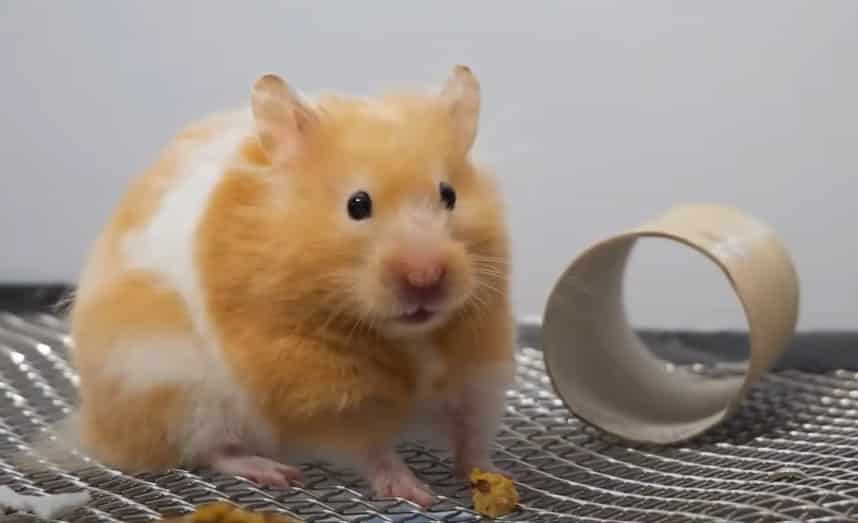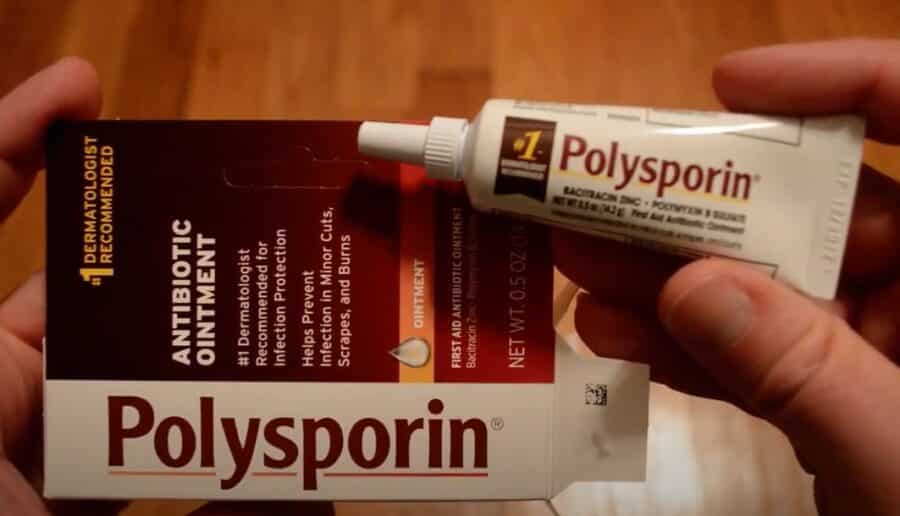Is your hamsters sore or wounded?
Will Polysporin do more harm than good?
In this article, we’ll discuss if Polysporin should be recommended or applied on hamsters.
Can You Use Polysporin On Hamsters?
Yes you can use Polysporin or Neosporin on hamsters. Make sure to only use a small dose and keep well clear of their eyes, apply with only the end of a Q-Tip.
Seek a second opinion from your hamster’s vet if you do not feel comfortable applying antibiotics or antiseptics.

What Are The Active Ingredients In Polysporin?
Polysporin is an antibiotic ointment used for minor wounds such as:
- cuts
- scrapes
- burns
- sores
- mild skin infections
Polysporin does not contain neomycin. The 3 active ingredients are:
- Polymyxin B Sulfate
- Bacitracin Zinc
- Gramicidin
Can I Use Neosporin On My Hamster?
This is the million dollar question of the day. You will read opposing opinions, but the most important one comes from your trusted vet who takes care of your hamster in times of need.
They might not suggest Polysporin or any ointment that contains neomycin and bacitracin.
They are life threatening chemicals that could cause stomach issues, or fatalities in hamsters who are sensitive to them if ingested or applied their eyes.
Other vets will ask you to proceed with caution and only apply a very thin film by using a tiny dab on the end of a Q-Tip.
Do not overuse if the area affected is not showing any recovery in 2-3 days. Stop its use and ask your hamster’s vet for more information or alternatives.
Can I Put Antibiotic Cream On My Hamster?
Hamsters are very sensitive to any form of internal or topical antibiotics. Apply or administer them with extreme caution. Start with a spot cleaning of any skin issues with lukewarm water on a cotton ball.
Alternative therapies include spot cleaning with green tea as well, but the effects or claims of its success with treating wounds are unproven and cannot be supported with scientific evidence.
Polysporin is a popular antibiotic cream designed for humans, but very tiny doses have been used for hamsters or other pets with relative success for mild cases.
Recommended Reading : Has the hair of your hamster changed recently? Is this something to worry about? Check out the reason here
What Can I Put On A Hamster’s Cut?
If your poor little companion has suffered a cut or wound, you would like to help in any way possible. Start with a gentle application of warm water on a Q-tip or cotton ball.
The following products intended for humans should be avoided if possible:
- plasters
- bandages
- antiseptics
- creams
A wound that that is bleeding might need a vet’s assistance if it’s deep. Using Polysporin is debatable due to its inception and creation for humans only.
Hamsters who receive topical ointments must be kept as far from their faces as possible as they will try to lick it off. Discourage licking and keep your hamster busy with a sunflower seed or other treats instead.
How Do You Treat A Hamster’s Skin Infection?
Although we have some experience working closely with vets, we are not medical professionals who can treat skin infections.
Once an infection has set, it’s a virus or bacterial infliction that could be developing fluids under the skin. Your hamster’s vet will decide on the course of treatment ranging from:
- hydrating liquids
- supplements
- antibiotics
You will not be able to treat a spreading infection by yourself. Keep the area clean and your hands as well to not transfer any infection to yourself.
I recommend to bathe the wound once a day which will help in the recovery.
What Antibiotics Can Hamsters Take?
We are not able to provide a complete list of antibiotics suitable for hamsters without a prescription. Your hamster’s vet has the following choices of antibiotic treatments available to administer and prescribe and possibly more.
Here are some of the medications available:
- doxycycline
- enrofloxacin
- trimethoprim-sulfamethoxazole
Why Is My Hamster’s Fur Sticking Up?
There many possible reasons why your hamster looks like he or she just woke out of bed. Here are some reasons why your hamster’s fur is sticking up:
- lack of grooming
- allergies
- ringworm
- mites
- skin infection
If your hamster is itchy or constantly scratching, then the condition could be getting worse. Diagnosing the problem if its persists will be hard to do on your own.
Your fellow hamster enthusiasts try to help in any way they can by examining any photos you might upload in forum communities.
But we are not going to be able to prescribe treatment from afar. Seek a vet’s help if grooming is not the issue.
Is Neosporin Safe for Hamsters?
We cannot say that Neosporin is safe for hamsters, but you can still consider using this topical ointment if you safely apply it. Neosporin was not created for hamsters with the active ingredients being
neomycin and polymyxin B.
In minimal doses for humans, these toxic chemicals can kill a hamster who accidentally ingests it. Can you apply this ointment with assurance that your hamster cannot lick it off? If the wound is on the back and hard to reach, I would take a small risk and apply the smallest amount at the end of a Q-tip.
Hamsters are very sensitive to antibiotic-associated clostridial enterotoxemia. This is why we don’t take chances when it comes to using medications from our own cabinets intended for us and applying it on hamsters.
Consult a vet and or choose to use a similar ointment that they will give to you for your hamster’s wounds or infections. Keep them labeled and save the remaining amount of ointment for the future.
Alternatively, you can visit a pet shop and see what they have for topical ointments intended for sensitive rodents such as hamsters.
Is Polysporin Safe for Hamsters?
Do not use this article as a reference or recommendation to apply a very strong antibiotic ointment intended for humans such as Polysporin on a hamster. Proceed with caution at your own risk.
Polysporin has been used on hamsters in many situations, but there have been complications. If the ointment is accidentally entering the opening of a hamster such as nostrils, mouth or anus, there could be fatal consequences.
Hamsters should never be able to lick this ointment off. This is why we have applied Polysporin with the end of Q-tip and worked it into the affected area where there was no moisture remaining.
We also keep it away from their eyes and mouth. Consider using hydrogen peroxide, iodine, salt water and refrain from immediately resorting to human grade ointments made of antibiotics and chemicals that were never intended for hamsters.
Difference Between Neosporin and Polysporin
My last visit to the local pharmacy had me confused. I saw Polysporin and Neosporin together side by side for the first time in my life. My mind has associated them into one product and one memory.
I thought they were exactly the same thing. I was wrong. Polysporin does not contain neomycin, which Neosporin does. Think of both products as brand names for larger companies.
The main active ingredients in Polysporin is:
- bacitracin zinc
- polymyxin B sulfate
Neosporin contains the following active ingredients:
- bacitracin zinc
- polymyxin B sulfate
- neomycin sulfate
If you or a loved one has any issue with skin sensitivities, start with Polysporin over Neosporin if possible because it contains one less ingredient to be concerned about.
If you do not experience adverse reactions, allergies or the condition has improved, this is the ointment of your choosing.
If Neosporin has been recommended to you by a doctor or vet, you can rely on their advice for now and see if this works for you.
Can You Overuse Neosporin and Polysporin?
Yes. You can definitely overuse antibiotic ointments and end up with worse skin than you had before. We are advised to follow the dosage recommendations on the packaging, but in many cases, we should use even less.
A company wishes for you to run out of the product and go back to the store to buy more. A doctor or impartial professional may recommend a dose that is miniscule in comparison to what is being recommended.
This is especially true if you are intending to use Polysporin or Neosporin on animals. A tiny dab on the end of a Q-tip is all you need to use for now. You can end up with complications of overuse such as:
- Dermatitis
- Red skin
- Scaling
- Itchiness
Be careful with the use of either porridge and always remember that less is more in such cases when using antibiotic ointments.

What’s Wrong With My Hamster’s Eyes?
Your hamster may be experiencing common eye issues that could lead to crusting around the area or worse. Applying ointments or petroleum jelly is not advised.
The following cases occur with hamsters and need treatment:
- Conjunctivitis
- Ulcers
- Proptosis
1. Conjunctivitis
Conjunctivitis is also known commonly as pink eye. It’s an infection that causes drainage. A vet will help to prescribe something better than Polysporin which will only worsen the issue.
2. Ulcers
An ulcer could develop on your hamster if the eye is constantly scratched out of irritation. Rubbing, cloudiness or shutting of the eye are common symptoms. It needs to be sorted out sooner than later before it gets worse.
3. Proptosis
Proptosis is a scary situation when the eye is forcing its way out of the socket. Your hamster may have squeezed or pushed too hard. It’s an emergency and needs urgent assistance.
Do not use Polysporin or antispetics in any of the cases above. Refrain from applying ointments anywhere near the eyes, face or mouth.
Conclusion
We cannot advocate the use of Polysporin in this article. It simply wouldn’t be responsible of us to do so. Handle with caution if you proceed to do so.
Apply a thin layer to minor wounds away from your hamster’s face and give treats for your hamster to chew on while the ointment dries.


